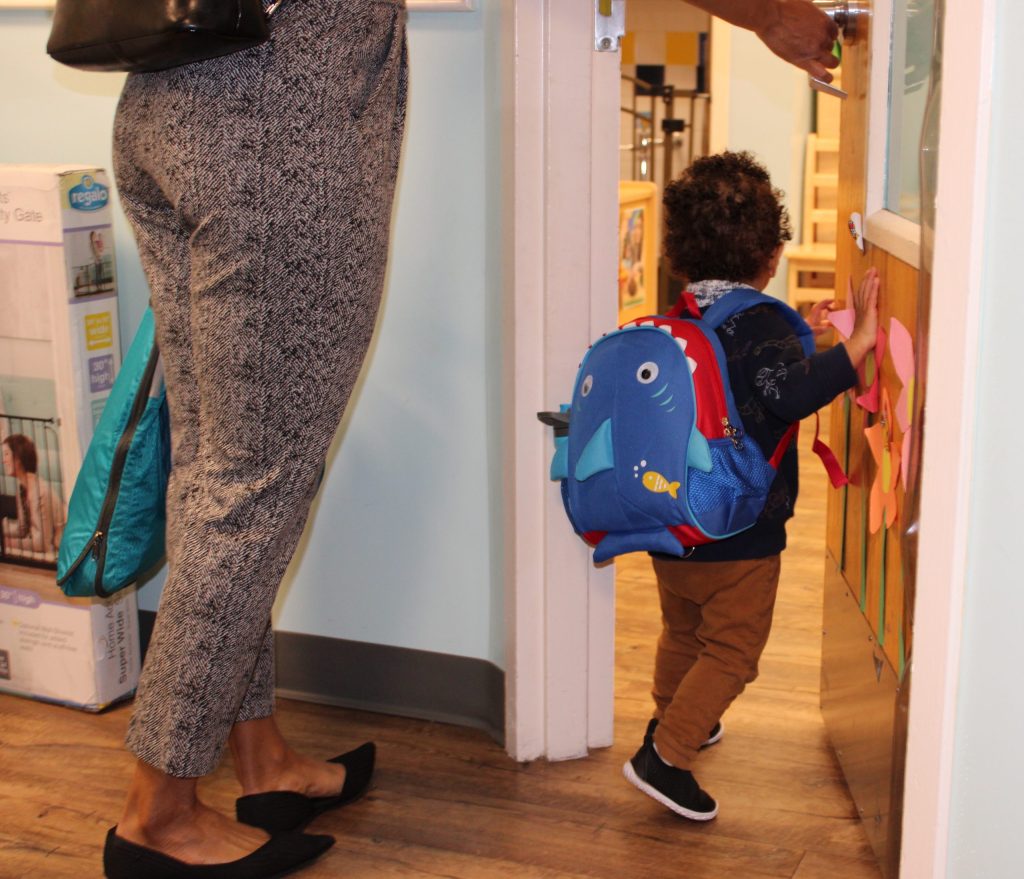LAS VEGAS and RENO, Nev. — They exist in places like an airport, a resort, and a distribution center, tucked away from the public eye but close enough for easy access. They often emit laughter – and the sound of tumbling blocks, bouncing balls, and meandering tricycles.
They’re child care centers based at workplaces. And in the increasingly fraught American child care landscape, they are popping up more frequently.
Skyrocketing child care costs and staffing shortages have complicated arrangements for working parents. Some have left their jobs after struggling to find quality care. Employers, in turn, view their entry into the child care realm as both a competitive advantage and a workplace morale-booster.
“In the absence of government intervention and investment, a lot of businesses have been stepping up to make sure that their employees can access affordable child care,” said Samantha Melvin, an assistant research professor at the Erikson Institute, an independent graduate school for early childhood education.
Parents benefiting from child care at their work sites praise the model, given its convenience, affordability, and peace of mind. They can stop by to breastfeed or eat lunch with their little ones. And it doesn’t add time to their morning commutes.
Frances Ortiz, who works in accounting at The Venetian Resort Las Vegas, can’t imagine a better option. She says her 3-year-old daughter has gained independence and language skills – with Mom not far away – at the property’s on-site child care center for employees.
“She runs in here,” Ms. Ortiz said. “She grabs my badge. She has to open the door for herself.”
In September, the Pittsburgh International Airport added its own on-site child care. The center, which is run by a child care operator, serves children of Allegheny County Airport Authority employees as well as those of select airport workers, such as food and beverage workers, ground handlers, and wheelchair attendants.
Airport officials say the idea stemmed from wanting to bring more women and people of color into the aviation workforce. Plus, the airport sits 17 miles outside of downtown Pittsburgh, making child care logistics challenging for employees. So far, it’s operating at about half capacity, with more enrollments expected over the next few months.
Join us Wednesday May 22 at 2:30 CST for an Education Reporting Collaborative event led by the Seattle Times and AL.com, focused on the child care crisis and how to fix it. Panelists include Sen. Katie Britt (R-Ala.), Sen. Patty Murray (D-Wash.) and Lisa Hamilton, CEO of the Annie E. Casey Foundation. Follow this Facebook event for details.
“It’s certainly an important proof point to our team that we mean it when we say that we’re invested in them and in what they need,” said Christina Cassotis, CEO of the Allegheny County Airport Authority, which operates the Pittsburgh airport.
An added bonus for the children: windows with views of planes taking off and landing.
Related: Our biweekly Early Childhood newsletter highlights innovative solutions to the obstacles facing the youngest students. Subscribe for free.
The average American family spends nearly a quarter (24 percent) of its household income on child care, according to a survey this year from Care.com. The cost can eclipse rent or mortgages, if parents can access care in the first place. Many find themselves on waitlists.
As employers contemplate entering the child care realm, Ms. Melvin encourages them to find out what their workers want. What hours do they most need care? Are they looking for center- or home-based care?
The Care.com survey suggested that 30 percent of parents would like to see their employers provide on-site day care, while others identified child care subsidies (28 percent), flexible spending accounts (22 percent), and backup care (21 percent) as desirable workplace benefits.
More public and private employers appear to be heeding the call, though how they assist runs the gamut. Some fully run their own centers. Others outsource the operations and management to providers.
The financial arrangements also differ. Many companies and organizations don’t disclose the exact discounts offered to employees, but they tend to be more affordable than or at least competitive with local rates.
Walmart, for instance, recently opened an on-site child care center at its massive Bentonville, Arkansas, campus. The Little Squiggles Children’s Enrichment Center chargesa monthly rate of $1,117 to $1,258, based on the child’s age, which company officials tell the Monitor in an email is “at market rate or below regional levels for comparable care.”
Related: ‘I can be mom and teacher’: Schools tackle child care needs to keep staff in classrooms
Another method gaining steam: employers providing subsidies for families to use toward child care options within their own communities.
KinderCare, a large child care operator with locations nationally, partners with more than 600 businesses and organizations to provide employee-sponsored child care, up from 400 in 2019, says Dan Figurski, president of KinderCare for Employers and Champions. Those employers represent the technology, medical, banking, academic, and public service industries, among others.
The amount of financial assistance they’re extending to employees varies, he says, with some covering up to 90% of child care costs.
Just under 100 children were enrolled at the KinderCare Child Development Center at The Venetian Las Vegas as of mid-April. They’re children of employees in departments as varied as housekeeping and accounting. Credit: Jackie Valley/The Christian Science Monitor
Mr. Figurski expects more companies to view child care as a benefit for their employees, not unlike health care.
“I do think the future is some blended model of government-subsidized and employer-subsidized child care moving forward so that every child has access,” he says.
Experts who study child care, however, caution against an overreliance on businesses filling the void. Philip Fisher, director of the Stanford Center on Early Childhood, says doing so could undercut efforts to recognize child care as a public good.
“There’s a lot of well-intentioned people who are thinking this is a really good idea, and for those who would benefit from it, it could be,” he says. “Again, there are lots of downsides even in the short term.”
One of those potential pitfalls, he says, is instability if a parent suddenly loses their job and then has to find new child care and a new job.
Related: What convinces voters to raise taxes: child care
In Nevada, The Venetian Resort’s child care center, run by KinderCare, sits in a back-of-house hallway steps away from the famous Las Vegas Boulevard.
All employees can enroll their children, as long as space allows, at a cost that’s generally 35% to 40% lower than KinderCare’s normal rate, says Matt Krystofiak, the Venetian’s chief human resources officer. The company also offers subsidies for employees who want to enroll their children in an off-site KinderCare closer to their homes.
“We’re doing this because this is what our team members want,” he says. “This is what our team members need.”
Fixing the Child Care Crisis
This story is part of a series on how the child care crisis affects working parents — with a focus on solutions. It was produced by the Education Reporting Collaborative, a coalition of eight newsrooms that includes AL.com, The Associated Press, The Christian Science Monitor, The Dallas Morning News, The Hechinger Report, Idaho Education News, The Post and Courier in South Carolina, and The Seattle Times.
Businesses such as Patagonia, another longtime leader in the space, also view child care as a reflection of their company culture.
The clothing retailer’s foray into child care began organically in 1983 when some of the company’s original employees started having children. As Patagonia grew, so did its child care footprint. Nowadays, the clothing company operates three child care centers – two in Southern California and one in Reno, Nevada – serving roughly 200 children.
The company conducts research annually to determine the cost to employees in each location, which leaders describe as an “average market rate.” Subsidies are available based on household income, says Sheryl Shushan, Patagonia’s director of global family services. The child care teachers are employed by Patagonia, so they receive corporate benefits as well.
On a recent morning, a 16-month-old boy toddled up a small embankment to touch wind chimes hanging from trees. His teachers watched from a short distance away in the outdoor classroom at Patagonia’s distribution center in Reno.
“We believe that risk-taking builds character,” says Terry Randolph, program manager for the site. In this play-based environment, children spend hours outside, digging in sand, riding bikes, playing with water, or climbing natural and human-made objects.
Patagonia leaders say the benefits on their end are stronger employee retention, a can-do spirit in the workplace, and a greater sense of community.
“There’s an opportunity to see co-workers as parents instead of just employees,” she says. “It just creates connection and purpose beyond the project you’re working on.”
For Alyssa Oldham, a classroom manager in Reno, the job and child care benefit meant rethinking her family size. She and her husband originally envisioned being a one-child family, given child care costs.
Now she comes to work holding two tiny hands belonging to her 4-year-old son and 1-year-old daughter.
“Working here, I was like, ‘We could have another child,’” she says.
Jackie Valley is a staff writer for The Christian Science Monitor.
This story is part of a series on how the child care crisis affects working parents — with a focus on solutions. It was produced by the Education Reporting Collaborative, a coalition of eight newsrooms that includes AL.com, The Associated Press, The Christian Science Monitor, The Dallas Morning News, The Hechinger Report, Idaho Education News, The Post and Courier in South Carolina, and The Seattle Times.
© 2024 The Christian Science Monitor
The post More companies open on-site child care to help employees juggle parenting and jobs appeared first on The Hechinger Report.
LAS VEGAS and RENO, Nev. — They exist in places like an airport, a resort, and a distribution center, tucked away from the public eye but close enough for easy access. They often emit laughter – and the sound of tumbling blocks, bouncing balls, and meandering tricycles. They’re child care centers based at workplaces. And
The post More companies open on-site child care to help employees juggle parenting and jobs appeared first on The Hechinger Report. Early Education, The South, Child Care, Fixing the Child Care Crisis, Parents, poverty The Hechinger Report









